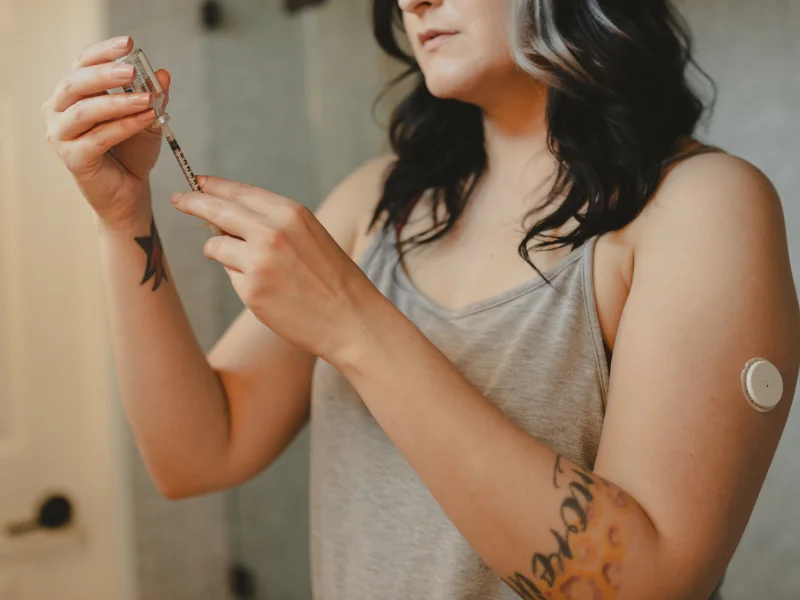Understanding Insulin: The Key to Effective Diabetes Management

One of the first things most people associate with diabetes is insulin. Most people know that it is an important medication in treating diabetes but may not know exactly why. Let’s take a quick look at what insulin does in the body so we can better understand its role in diabetes management.
Insulin is essential for the uptake of glucose into the cells for energy. Our body needs to be able to move glucose from the bloodstream to the cells all day long. And to move glucose, insulin is needed. Insulin attaches to receptors on the cell surface, acting like a key unlocking the door of the cell so that glucose can move into the cell for use.
Over the course of the day, we need various levels of insulin. When we are resting, we need to move small amounts of glucose into cells to maintain energy levels. In comparison, we need a large amount of insulin present when we eat to move the glucose influx from food into the cell. We talk about these different levels of insulin secretion as basal and bolus. Basal insulin secretion is a small trickle of insulin that is released around the clock to allow glucose into cells so that we can continue to function when food isn’t present. Bolus insulin secretion is a large amount that is released from the pancreas when food is present to move the incoming glucose from the food into cells.
The goal of insulin therapy is to mimic the actions of our body as closely as possible. There are essentially two types of insulins used in the treatment of diabetes: long-acting insulin which mimics basal secretion and short-acting insulin which mimics the bolus secretion of insulin.
For people with type 1 diabetes, their body no longer produces insulin so both basal and bolus insulin will need to be used to maintain goal glucose levels. For those with type 2 diabetes, the body is still producing some insulin but maybe not enough for their body’s needs. Basal insulin is typically initiated first to help supplement their insulin needs, but bolus insulin may be needed at some point to maintain optimal glucose levels.
Basal insulins, used to mimic that little trickle of insulin the body produces all day long, are sometimes called long-acting insulin due to their long duration of action in the body. They are given one or two times per day depending on their length of action. The oldest basal insulin is NPH. This is what we refer to as intermediate-acting insulin because its duration of action is approximately 12 hours, so it needs to be given twice a day to maintain the “trickle” of insulin all day long. NPH also has a peak. This means that as it is absorbed into the body it has increasing action for about 6 hours and then decreasing action. Because of the variability of action, it can lead to the risk of hypoglycemia during periods of increased activity. Newer basal insulins include glargine, detemir, and degludec. They are considered long-acting basal insulins because they have durations of action anywhere from 18 to 42 hours. They also have more consistent absorption so there is not a “peak” like with NPH. With the majority of these insulins only one dose per day is needed, although twice daily dosing may be needed with higher doses of glargine. Degludec is unique because it has a long duration of action, up to 42 hours. But dosing can be as close as 8 hours apart or as long as 36 hours apart with no increased risk of hypoglycemia or losing coverage. This makes it ideal for people who might work overnight or swing shifts where dosing of insulin can become challenging. All basal insulins must be administered via subcutaneous injection, either with needle and syringe or through pen or smart pen devices.
Bolus insulins are used to mimic the larger amount of insulin that is released at meals. These are shorter-acting insulins that “get in” to quickly start bringing down post-meal glucose than “get out” to avoid hypoglycemia due to having too much insulin in the system. Regular insulin is our oldest bolus insulin, and it is referred to as a short-acting insulin. This insulin takes a little more time to start working on meal-time glucose, usually 30 to 60 minutes before it is active, and it hangs around for 4 to 6 hours. The newer bolus insulins, aspart, lispro and glulisine, are referred to as rapid-acting insulins. They are working on bringing meal-time glucose down within 5-10 minutes and are at their peak activity by 30-60 minutes. These insulins don’t hang around for very long either being out of the system within 3 hours. This leads to less hypoglycemia risk versus regular insulin that can hang around for up to 6 hours. All of these bolus insulins are administered via subcutaneous injection, via syringe or pen device, but also can be used in insulin pumps. Within the insulin pump, they act as not only the bolus but also as the basal insulin! But that’s a topic for its own article!
There is one more bolus insulin option, inhaled insulin. When insulin is inhaled into the lungs it is absorbed quickly with the onset of action within 10 minutes. It also does not stay in circulation for more than 3 hours. The major challenge with inhaled insulin is how the insulin is dosed. The insulin comes in cartridges that are put into the inhaler. These cartridges come in 4, 8, and 12 unit increments. This means if you need 16 units of insulin to cover your mealtime needs you will have to inhale a 4 unit cartridge then a 12 unit cartridge (or 2 – 8 unit cartridges). If you needed 14 units to cover your meal, you would have to decide between using 12 units or 16 units. Inhaled insulin is effective and a suitable alternative for patients wanting to minimize injections, but it cannot be used by anyone who smokes cigarettes or vapes.
There are also split-mixed insulins which combine basal and bolus insulins in a set percentage. These are useful in minimizing daily injections but are harder to individualize therapy to needs because if you need to increase the basal insulin you will also increase the bolus insulin. There is also regular insulin U500 which is used for people who need substantial amounts of insulin daily. Due to its concentration, regular insulin U500 becomes both the basal and bolus insulin and is given two to three times per day.
The key points to remember about insulin therapy are:
1: Insulin mimics what the body does normally to regulate glucose levels.
2: Basal insulin, or long-acting insulins, provide the small trickle of insulin needed to keep the body going even while at rest.
3: Bolus insulin, or short/rapid-acting insulins, provide a burst of insulin when food is present to help move the glucose from that food into the cell to be used.
4: There are many options available for insulin therapy, the best combination is what works best for you.
References:
View References
1: Diabetes Care 2024; 47(Suppl.1):SS1-S309 / https://doi.org/10.2337/cd24-S005
2: Canagliflozin [package insert]. Titusville, NJ: Janssen Pharmaceuticals, Inc.; 2022.
3: Dapagliflozin [ package insert]. Wilmington, DE: AstraZeneca Pharmaceuticals LP; 2022.
4: Empagliflozin [package insert]. Ridgefield, CT: Boehringer Ingelheim Pharmaceuticals, Inc.; 2022.
5: Dulaglutide [package insert]. Indianapolis, IN: Eli Lilly Pharmaceuticals, Inc.; 2022.
6: Exenatide [package insert]. Indianapolis, IN: Eli Lilly Pharmaceuticals, Inc.; 2022.
7: Liraglutide [package insert]. Plainboro, NJ: Novo Nordisk, Inc.; 2022.
8: Lixisenatide [package insert]. Bridgewater, NJ: Sanofi-Aventis U.S. LLC.; 2022.
9: Semaglutide [package insert]. Plainboro, NJ: Novo Nordisk, Inc.; 2022.
10: Tirzepatide [package insert]. Indianapolis, IN: Eli Lilly Pharmaceuticals, Inc.; 2022
11: https://www.drugs.com/metformin.html
12: https://www.drugs.com/sulfonylurea.html
13: Sitagliptin [package insert]. Rahway, NJ: Merck Pharmaceuticals, Inc; 2023
14: https://www.drugs.com/onglyza.html
15: Linagliptin [package insert]. Ridgefield, CT: Boehringer Ingelheim Pharmaceuticals, Inc; 2023
16: https://www.drugs.com/pioglitizone.html
17: https://www.drugs.com/drug-class/insulin.html
18. https://www.mayoclinic.org/diseases-conditions/high-blood-cholesterol/in-depth
19: https://www.mayoclinic.org/healthy-lifestyle/weight-loss/in-depth
20: https://www.drugs.com/glucagon.html
21: Gvoke [package insert]. Chicago, IL: Xeris Pharmaceuticals. 2023
22: Baqsimi [package insert]. Rancho Cucamonga, CA Amphastar Pharmaceuticals. 2019
Written by






